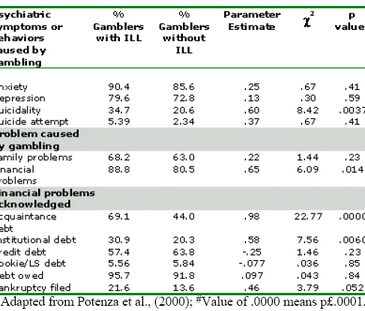Recent research (e.g., Meyer & Stadler, 1999) suggests a relationship between problem gambling, illegal activities, and associated personal, familial, and other social consequences. A study conducted by Potenza Steinberg, McLaughlin, Wu, Rounsaville, and O’Malley (2000) supports these conclusions and further posits that problem[1] gamblers who report legal problems secondary to gambling are more seriously troubled with psychiatric, gambling, and financial problems compared to problem gamblers with no reported legal problems.
Using data derived from a sample (n=826) of callers to the 24-hour helpline of the Connecticut Council on Compulsive Gambling, Potenza et al. (2000) categorized callers into two groups: those with legal problems secondary to gambling, or ILL, and those without these problems. Presence of ILL was determined by a positive response to at least one of the following criteria: (1) past, current, or pending legal action related to gambling; (2) arrest and/or incarceration caused by gambling; or (3) other illegal acts other than arrest or incarceration caused by gambling (Potenza et al., 2000).
The results reveal that ILL is significantly associated with elevated rates of suicidality secondary to gambling (Potenza et al., 2000). In addition, financial problems caused by gambling are significantly more likely to occur to gamblers with ILL than to those without it (Potenza et al., 2000). Moreover, both acquaintance and institutional debt were significantly linked to gamblers with ILL; bankruptcy filings were elevated but not statistically significant (Potenza et al., 2000). Table 1 below summarizes results that show the elevated rates at which gamblers with and without ILL experience gambling-related problems (i.e., anxiety, depression, and debt owed).
Table 1. Logistic Regression Analyses of Psychiatric, Gambling-Related, and Financial Variables Predicting ILL*
Although Potenza et al. (2000) have described a multitude of issues pertaining to the "problem" gambler, there are two primary reasons why not all of these conclusions are applicable to the full range of disordered gamblers. First, there is no distinction made among levels of gambling disorders: ". . .we will use the term ‘problem gambling’ to include the spectrum of gambling behaviors from pathological gambling. . .to less severe, yet disruptive, patterns of gambling (Potenza et al., 2000, pp. 389-390). Such a broad definition of problem gambling, while perhaps methodologically appropriate, does not generalize to level 3 and 2 gamblers in the general population since proportionately fewer level 3 and 2 gamblers call helplines. Consequently, the sample is not representative of any group other than helpline callers.
Second, the data rest solely on self-report. As such, it is difficult to determine if gambling-related problems result from legal difficulties or whether legal difficulties result from gambling-related problems. This issue further reveals a tautology in the data set itself: people with legal problems are classified in the ILL group. It would be more useful to compare the legal problems of disordered gamblers with ILL to the legal problems of disordered gamblers from the general population to determine whether statistically significant differences exist between these two groups. Nonetheless, Potenza et al. (2000) have thoughtfully illustrated the effect legal problems secondary to gambling can have on disordered gamblers.
[1] Potenza et al. (2000) use the term “problem gambling” to represent a range of gambling behaviors (i.e., levels 3 and 2).
References
Meyer, G., & Stadler, M. A. (1999). Criminal behavior associated with pathological gambling. Journal of Gambling Studies, 15, 29-44.
Potenza, M. N., Steinberg, M. A., McLaughlin, S. D., Wu, R., Rounsaville, B. J., & O’Malley,
S. S. (2000). Illegal behaviors in problem gambling: analysis of data from a gambling
helpline. The Journal of the American Academy of Psychiatry and the Law, 28(4), 389-403.
The WAGER is a public education project of the Division on Addictions at Harvard Medical
School. It is funded, in part, by the National Center for Responsible Gaming, the
Massachusetts Department of Public Health, the Addiction Technology Transfer Center of
New England, the Substance Abuse and Mental Health Services Administration, and the
Center for Substance Abuse Treatment.





